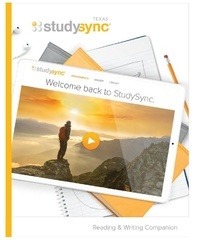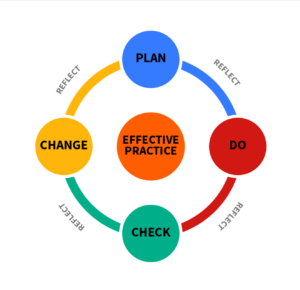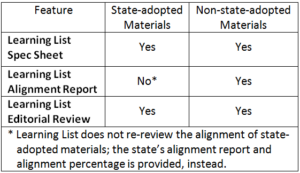Learning List recently reviewed McGraw Hill’s Texas StudySync, which was submitted for state adoption in Texas in response the Texas Education Agency’s  Proclamation 2019 call for K-8 English language arts and reading (ELAR) products aligned to the new ELAR Texas Essential Knowledge and Skills (TEKS). StudySync is a comprehensive product that supports English language arts/reading (ELAR) instruction in grades 6-12. Content is available in print and digital formats and is intended for blended learning environments. Learning List reviewed online resources for grades 6-8. Instruction centers on the close reading of a set of thematically-related texts with integrated lessons in reading comprehension, writing, and speaking and listening skills.
Proclamation 2019 call for K-8 English language arts and reading (ELAR) products aligned to the new ELAR Texas Essential Knowledge and Skills (TEKS). StudySync is a comprehensive product that supports English language arts/reading (ELAR) instruction in grades 6-12. Content is available in print and digital formats and is intended for blended learning environments. Learning List reviewed online resources for grades 6-8. Instruction centers on the close reading of a set of thematically-related texts with integrated lessons in reading comprehension, writing, and speaking and listening skills.
StudySync’s content is organized in six, 30-day thematic units at each grade level. Each unit focuses on an essential question and a genre. Most units address personal topics (e.g., “No Risk, No Reward”) and include content that relates to other subject areas, particularly social studies. Units integrate authentic literary and informational texts and culminate in an overarching project that requires students to respond to what they have read in either written or spoken format. Across middle school grades, texts vary in length and genre and address diverse individuals and cultures. [Read more…]
 Educators and publishers often use the terms “standards,” “curriculum” and/or “instructional materials” interchangeably. Moreover, many educators consider their instructional materials to be their curriculum. However, each of these terms represents a distinct component of an educational program. In the sections that follow, we provide explanations of each of these terms to differentiate their meanings in the context of PreK-12 education.
Educators and publishers often use the terms “standards,” “curriculum” and/or “instructional materials” interchangeably. Moreover, many educators consider their instructional materials to be their curriculum. However, each of these terms represents a distinct component of an educational program. In the sections that follow, we provide explanations of each of these terms to differentiate their meanings in the context of PreK-12 education.
 In a recent
In a recent 



 Over the last five years, we have learned a lot about instructional materials. One observation is that comprehensive and supplemental materials, including RtI and test prep resources, are designed very differently and are intended for different purposes. Another observation is that unless you use a material for its intended purpose, it is unlikely you will achieve the result you need.
Over the last five years, we have learned a lot about instructional materials. One observation is that comprehensive and supplemental materials, including RtI and test prep resources, are designed very differently and are intended for different purposes. Another observation is that unless you use a material for its intended purpose, it is unlikely you will achieve the result you need. Have you ever been frustrated when attempting to plan differentiated lessons? Though “differentiation” is a rather simple concept, it is complex to implement successfully.
Have you ever been frustrated when attempting to plan differentiated lessons? Though “differentiation” is a rather simple concept, it is complex to implement successfully.